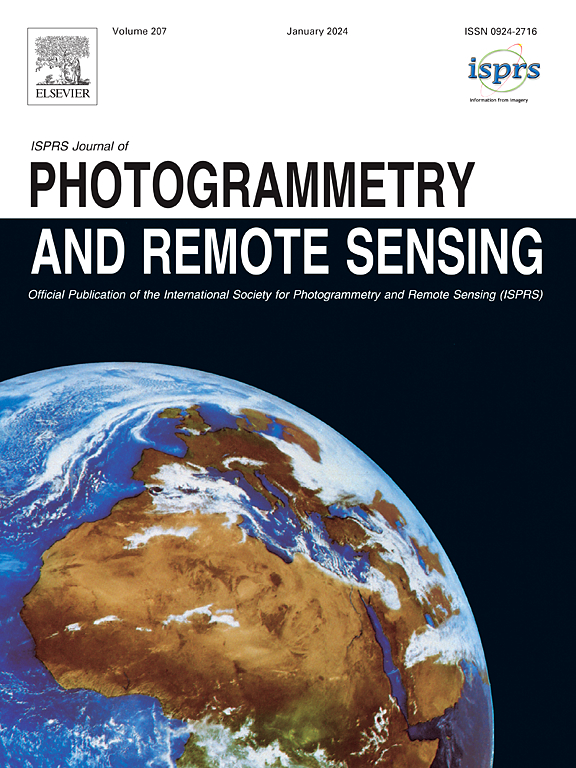IF 10.6
1区 地球科学
Q1 GEOGRAPHY, PHYSICAL
ISPRS Journal of Photogrammetry and Remote Sensing
Pub Date : 2025-04-09
DOI:10.1016/j.isprsjprs.2025.03.020
引用次数: 0
摘要
自前工业时代以来,甲烷(CH4)一直是导致全球变暖的第二大因素。人为甲烷排放(如石油和天然气、废物管理和煤炭开采)是甲烷释放的主要来源,同时也为减排提供了绝佳机会。在这方面,卫星遥感观测在甲烷检测和量化方面发挥了关键作用,进一步提高了甲烷研究的时间和空间范围。卫星数据的一个主要特征是存在短波红外(SWIR)甲烷吸收波段,这对于从太空中识别甲烷羽流至关重要。探测、监测和特征描述是基于卫星的甲烷研究的主要组成部分。一般来说,量化区域和点源的甲烷排放是文献中的两大挑战,过去几年在甲烷研究新技术的研究、开发和操作方面取得了巨大成功,特别是在后一个领域。因此,有必要对现有文献进行系统分析和审查,以确定从太空监测甲烷点源的当前趋势、技术和地球观测数据。因此,本研究系统地回顾了 77 项研究,并强调了卫星数据在检测甲烷点源排放方面的关键作用。文献指出,石油和天然气行业是报告的甲烷排放的主要来源,尤其是土库曼斯坦、美国和阿尔及利亚等国家。综述还将具有甲烷检测能力的仪器分为三大类,即高光谱、多光谱和 SWIR 光谱仪,每一类都有其独特的优势,并能解决其他数据源的局限性。文献中确定的空间甲烷点源排放监测的主要处理步骤是甲烷柱检索、掩蔽/探测和源速率量化。文献显示,虽然传统技术仍被广泛用于甲烷检测和量化,但基于人工智能的模型正在成为甲烷研究不同阶段的有用工具,并极大地解决了传统技术的局限性。甲烷点源研究的一般特征显示了大气科学和遥感领域的各种应用。在这些领域发表的论文数量不断增加,尤其是在影响力较大的期刊上发表的论文,凸显了甲烷监测的重要性和相关性。这些研究弥补了大气观测和遥感技术之间的差距,有助于更全面地了解全球范围内的甲烷排放情况。本文章由计算机程序翻译,如有差异,请以英文原文为准。
Advancements in satellite-based methane point source monitoring: A systematic review
Methane (CH4) stands out as the second-largest contributor to the global warming since pre-industrial era. Anthropogenic methane emissions (e.g., oil and gas, waste management, and coal mining) are the major sources of methane release and in the meantime provide an excellent opportunity for emission reduction. Regarding this, observations from satellite remote sensing paly pivotal role in methane detection and quantification, further enhancing the temporal and spatial extent of methane research. A key feature of satellite data is the presence of Shortwave Infrared (SWIR) methane absorption bands, which are essential for identifying methane plumes from space. Detection, monitoring, and characterization are the main components of satellite-based methane studies. In general, quantifying methane emissions from regional and point sources presents two major challenges in the literature and the past few years have witnessed a tremendous success in terms of research, development, and operationalization of new techniques for methane studies, particularly, in the latter domain. As such, there is a need for a systematic analysis and review of existing literature to identify current trends, techniques, earth observation data for methane point source monitoring from space. Accordingly, this study systematically reviews 77 studies and highlights the critical roles of satellite data in detecting methane point source emissions. The literature identifies oil and gas sector as a dominant source of reported methane emission, particularly from countries like Turkmenistan, the United States, and Algeria. The review also categorizes instruments with methane detection capabilities into three main types, namely hyperspectral, multispectral, and SWIR spectrometers, each offering their unique advantages and addressing the limitations of other source of data. The main processing steps for methane point source emission monitoring from space identified in the literature are methane column retrieval, masking/detection, and source rate quantification. The literature reveals while conventional techniques are still widely used for methane detection and quantification, AI-based models are emerging as useful tools in different stages of methane research and significantly address the limitations of conventional techniques. The general characteristics of methane point source studies reveal a diverse array of applications across both atmospheric science and remote sensing fields. The rising number of publications in these areas, especially in high-impact journals, underscores the importance and relevance of methane monitoring. These studies bridge the gap between atmospheric observations and remote sensing technologies, contributing to a more integrated understanding of methane emissions on a global scale.
求助全文
通过发布文献求助,成功后即可免费获取论文全文。
去求助
来源期刊

ISPRS Journal of Photogrammetry and Remote Sensing
工程技术-成像科学与照相技术
CiteScore
21.00
自引率
6.30%
发文量
273
审稿时长
40 days
期刊介绍:
The ISPRS Journal of Photogrammetry and Remote Sensing (P&RS) serves as the official journal of the International Society for Photogrammetry and Remote Sensing (ISPRS). It acts as a platform for scientists and professionals worldwide who are involved in various disciplines that utilize photogrammetry, remote sensing, spatial information systems, computer vision, and related fields. The journal aims to facilitate communication and dissemination of advancements in these disciplines, while also acting as a comprehensive source of reference and archive.
P&RS endeavors to publish high-quality, peer-reviewed research papers that are preferably original and have not been published before. These papers can cover scientific/research, technological development, or application/practical aspects. Additionally, the journal welcomes papers that are based on presentations from ISPRS meetings, as long as they are considered significant contributions to the aforementioned fields.
In particular, P&RS encourages the submission of papers that are of broad scientific interest, showcase innovative applications (especially in emerging fields), have an interdisciplinary focus, discuss topics that have received limited attention in P&RS or related journals, or explore new directions in scientific or professional realms. It is preferred that theoretical papers include practical applications, while papers focusing on systems and applications should include a theoretical background.
 求助内容:
求助内容: 应助结果提醒方式:
应助结果提醒方式:


